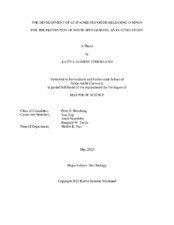| dc.description.abstract | Background and Purpose
There is no ideal way to prevent white spot lesions. Current fluoride-releasing products exhibit an initial burst, which severely limits the duration of the effects. O-rings incorporated with fluoride have been previously studied for a more long-term continuous release of fluoride, however, have been unsuccessful in attaining therapeutic levels to prevent white spot lesions. The present study will utilize a novel method of dip coating O-rings to achieve sustained fluoride release.
Materials and Methods
To solve the challenge, we developed a novel strategy to incorporate calcium fluoride
(400mg/ml) into 2.5%, 5% or 10% Polycaprolactone, and coated O-rings (n=16). Control and calcium fluoride O-rings were placed on upper lateral incisor brackets and soaked in distilled water. The amount of released fluoride was tested weekly for 7 weeks. Elastic properties were assessed with the Instron Mechanical test. Scanning electron microscopy investigated the integration of fluoride onto the O-rings.
Results
The average release rates of the 2.5%, 5% and 10% groups were 5.3, 10.3 and 10.0 (µg F-/ring/day, respectively. These were all higher than the therapeutic range (1.2-2.8 (µg F-/ring/day) and much lower than the toxic level (51 µg F-/ring/day). At the 7th week, the average daily release rates for 2.5%, 5% and 10% groups were 0.7, 6.5 and 7.0 (µg F-/ring/day, respectively, indicating a continuous effective fluoride release in 5% and 10% groups. Scanning electron microscopy showed successful integration of calcium fluoride onto the outer layer of the O-ring. Instron test revealed no significant change in elastic properties of the O-rings after coating.
Conclusions
The 5% and 10% groups of calcium fluoride O-rings exhibited long-term sustained and therapeutically effective fluoride release. This novel method can effectively and reliably coat PCL incorporated with calcium fluoride on the surface of O-rings. The calcium fluoride O-rings maintain elastic properties even after this dip coating modification. This study is promising for the possibility of calcium fluoride O-rings as a product for the prevention of white spot lesions in orthodontic patients. | |


